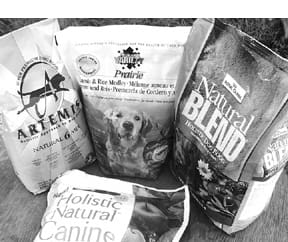How should you select your dog’s food? When you walk into your local pet food store, and walk the miles of aisles of stacks of bags, what is it that makes you grab that sack, and not any of the others? Is it:
• price?
• label claims or package appearance?
• the recommendation of a friend?
• your veterinarian’s prescription?

Bzzzzzzt! Bad answers! Here’s why:
Price: The most expensive foods are not always the best ones in a store (they are not even necessarily good!). Many chain pet stores charge a small fortune for foods that (by our criteria, described further along) are no good at all. Generally (but not always) we find the best foods in small, independent stores and where, interestingly, the prices for the great foods are not much higher than the chain stores charge for their (low-quality) “best.”
On the other hand, you can be certain that the least expensive foods are generally not good. This is not snobbism, by the way. It costs the manufacturer more to buy top-quality ingredients, and it’s only reasonable to expect that he will have to pass along those costs. And if a food costs pennies per pound, you can be assured that its contents cost the maker next to nothing – in other words, the food is vitamin-fortified sawdust, more or less. (And to take care of the inevitable question, “Can’t a dog live on vitamin-fortified sawdust?” we’ll say right now that the answer is, “Yes, but if you take that approach, you can expect to pay every penny you’ve saved in veterinary bills later.”)
Label claims, package appearance: Each and every day, the food makers are getting more sophisticated in their approach to packaging. They know that dog owners are becoming increasingly health-conscious and interested in dog food ingredients, so they are rushing to show us how healthy their foods are – and we do mean “show.” We haven’t seen so many beautiful depictions of vegetables and grains since Andy Warhol’s time. And the label descriptions! Carefully rhapsodic!
Unfortunately, there’s rarely a correlation between what’s shown on the bag and what’s in the bag. Perhaps the most notorious example of this is Purina’s new food, Beneful. (What a name, eh? Beneficial, bountiful, it’s all there. You have to hand it to them.) The front of Beneful’s bag shows fresh ears of corn, snappy unshelled peas, and gorgeous green-topped carrots. In fact, what it actually contains is ground corn, used here as a dried grain and a lower-cost source of protein, and dried peas and dried carrots. The latter, by the way, appear 17th and 18th on the list of ingredients, far below sugar (10th), sorbitol (another sweetener, 11th on the list), and even sorbic acid, a preservative that appears 15th on the list of ingredients. Purina must be counting on people to take one look at the color photographs of the vegetables, read the word “vegetables” on the front, and assume that “Gee, Purina really has come around, putting fresh veggies in its food!”
As far as we’re concerned, this food is a perfect example of everything that’s wrong with the conglomerate dog food industry; it’s all sizzle and very little steak (beef is 7th on the list of ingredients). The product has been manipulated in every way possible to appeal to humans, complete with a variety of cute shapes, artificial colors, and chemically enhanced textures, a pretty bag, and lots of healthy-sounding adjectives (wholesome, moist, meaty, real, vitamin-rich). But the contents don’t come close to fulfilling all this promise.
The recommendation of a friend: Your friend may, in fact, feed her dog the best possible food – for that dog. In no way does that guarantee that her dog’s food will agree with your dog.
Feeding dogs is an individual matter. Everything including the dog’s size, age, breed, health, activity level, allergies, intolerances, condition of teeth, past nutritional status, and even the his preferences will affect whether he thrives or merely survives on a given food. We don’t want to discourage you, but we know people who have to buy their three dogs three different foods. All three dogs look like a million bucks, so that’s that.
Your veterinarian’s prescription: Would this be a good time to mention that veterinarians who register for an online account with Hill’s, makers of Science Diet, can expect, as its Web site tantalizes, “convenient, easy ordering with real-time pricing and product availability plus a chance to win a Porsche”?
Sorry, but not many veterinarians know much more about nutrition than your next-door neighbor. But when they’ve been given free Hill’s dog food in vet school, their veterinary nutrition textbooks have been underwritten by Hill’s, and written by Hill’s researchers, is it any wonder they have really good feelings about Hill’s products?
Good answer!
All right, you’re overdue for some positive reinforcement. Here’s the best possible answer to the question, “How should you select your dog’s food?”
“I choose the food that appears to have the largest amount of whole, top-quality ingredients, and the smallest amount of low-quality or undesirable ingredients, and that my dog thrives on.”
In our opinion, the list of ingredients, printed by law on every bag of dog food, is the best source of information about a food. You don’t need a veterinarian, or us, for that matter, to tell you what is a good food and what is an exceedingly mediocre food; you just need to teach yourself to recognize the hallmarks of each kind of food. We’ve boxed this information for you on page 20 (“The Good, Bad, and the Mediocre: What the List of Ingredients Indicates”). Don’t take our word for it! Compare the ingredients, and decide for yourself; it’s really not that difficult. Look for a food that contains lots of the “hallmarks of a high quality food,” few of the “high-quality foods should contain a minimum of. . .” traits, and none of the “hallmarks of a low-quality food.”
Then, have your dog try it. Give him a month or two on the food. If he breaks out in itching fits, begins licking his paws incessantly, develops an ear infection, or has dramatic digestive reactions, give the food away and try another one! If, on the other hand, he’s always had one or more of the aforementioned symptoms, and they clear up, you’re on the right track. A good dog food will contribute to a healthy coat, good energy level, balanced temperament, and flawless health.
One final word about what’s “best” for your dog: It might change. As dogs age, their nutritional requirements change. They can develop food allergies or intolerances at any point in their lives. Don’t get so attached to a food that you fail to see whether it’s failing your dog. It may be a good food, but if it’s not working for your dog, there is no point in buying it.
Our selection criteria
We’ve told you how we suggest selecting a food. On the following pages, we will share with you a few foods that we think are above average. But we should probably also explain what we did NOT do when we picked these foods:
• We DID NOT conduct lab tests to make sure the “Guaranteed Analysis” printed on the label accurately reflects the contents; that’s the job of state feed control officials, and way beyond the scope of our resources.
• We DID NOT inspect manufacturing plants or investigate the manufacturers’ Boards of Directors. We hear rumors all the time about company owners who are rude or even big, fat liars. We hear about moldy food and mislabeled bags. If you experience one of these things, we suggest that you call the company and let them know they have a problem – and that you select another food.
• We DID NOT select foods on the basis of protein or fat content; more is not always better. Some dogs need more; some dogs need less.
• We DID NOT examine every food on the market. That would be impossible! You may find a food that looks as good or better than ours. Good for you! Send us some information about it; we’d love to share.
• We DID NOT rank-order the foods. They are presented in alphabetical order, because, remember, what’s “best” for your dog isn’t necessarily best for ours’.
ALL the following foods are good; we like them all. And, for the record, we still like all the foods we’ve selected in the past. If we’ve named a food before that does not appear here, it’s due to space limitations, not because it’s fallen out of our favor.
Also With This Article
Click here to view “Shopping for Top-Quality Dog Treats – It’s All in the Ingredients!”
Click here to view “Focusing in on The Main Ingredients in Commercial Dog Foods”
Click here to view “Homemade Dog Food Ingredients: 3 Essential Foods for Dogs”
-by Nancy Kerns






